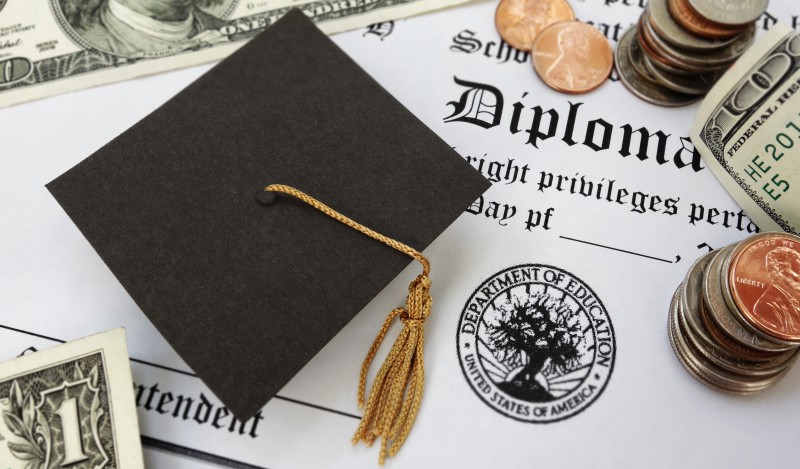
Experts urge government to treat student loans as grants and collect payments in taxes.
Over 45 million Americans owe about “$1.6 trillion in student loan debt.” But the real problem with the U.S. system for financing higher education is not the size of the debt but the lack of relief for struggling borrowers, according to a recent paper by two law professors.
John R. Brooks and Adam J. Levitin of the Georgetown University Law Center conclude that, if the government applied existing protections to all qualified borrowers, it could make student loans more affordable for borrowers as well as government. Implementing the necessary changes, though, would require an existential shift in how the federal government regulates these loans, Brooks and Levitin argue.
A core tenet of the existing federal education finance system holds that a student loan is indeed a loan. But Brooks and Levitin argue that student debt functions unlike ordinary consumer debt. The conventional understanding misses student loans’ “economic reality.”
Brooks and Levitin suggest that, realistically, student loans operate as government grants “coupled with a progressive, income-based tax.” Unlike borrowers who take out mortgages and car loans, the vast majority of student borrowers owe their debt directly to the U.S. Department of Education, not to private lenders. Also, unlike consumer borrowers, student borrowers receive loans regardless of their ability to repay, which may lead to greater rates of loan default and delinquency when compared to other loans.
Borrowers of federal student loans have access to a variety of protections that most consumer borrowers do not. Most of these federal student loan borrowers can opt-in to “income-driven repayment” plans, which forgive any debt remaining after borrowers pay a percentage of their discretionary income over a fixed period of time. Some borrowers can discharge their debt entirely if they can show that they have a “total and permanent disability.” Others can discharge their loans if their schools shut down before they graduated or if they are employed in public service for a fixed period of time.
These protections are critical because, if borrowers default on their student loans, they usually cannot discharge their debts in bankruptcy. The government also has several collection tools at its disposal that private lenders do not. For example, the government can seize wages without a hearing by withholding tax refunds or seizing Social Security benefits. Unlike private lenders, the government can sue defaulted borrowers for the rest of their lives to collect unpaid debt.
Despite having access to a variety of unique protections before default and relatively few protections after, student borrowers underuse these protections. Brooks and Levitin argue that the government could fix this servicing problem by “abandoning the debt paradigm” in favor of a “grant-and-tax” model. Although the federal government would still treat student loans “as a credit program” to the Education Department for budgeting, Brooks and Levitin suggest that the Internal Revenue Service (IRS)—not the Education Department—should be responsible for collection operations.
Brooks and Levitin propose that the federal government implement “a progressive, graduated schedule of marginal repayment rates” to borrowers’ wage withholdings and tax return filings. Instead of providing an income-driven repayment option for which borrowers have to apply, it would be the default repayment plan for all borrowers.
If the government collected repayments through a progressive tax, Brooks and Levitin argue that it could limit the amount borrowers owe on the principal by reducing interest rates to the rate of inflation, as Australia currently does. To subsidize this reduction in interest rates, Brooks and Levitin would have the IRS do away with the loan forgiveness currently offered under income-driven repayment.
Eliminating loan forgiveness might appear to impose an additional burden on borrowers, but Brooks and Levitin argue that doing so along with reducing interest rates to inflation would cut the total amount that borrowers pay more than any current income-driven repayment plan would. Borrowers would need less loan forgiveness after a fixed period of time because the total amount they owe would grow more slowly thanks to the proposed interest reduction and because their monthly payments would be income-driven.
Moreover, since taxes do not appear as liabilities on consumer credit reports, income-driven repayment would not affect people’s access to consumer credit. As a result, borrowers could take much longer to repay their loans without suffering the financial harms typically associated with longer repayment, including lower credit scores.
At a time when public debate over student loans tends to focus solely on whether and to what degree President Joseph R. Biden should pursue student loan cancellation, Brooks and Levitin offer a distinctive perspective on the problem’s root causes. “Grant-and-tax” may generate less enthusiasm from some than “cancel the debt,” but the reforms that Brooks and Levitin propose may be just as powerful and perhaps more appealing to a President wary of more dramatic intervention.



